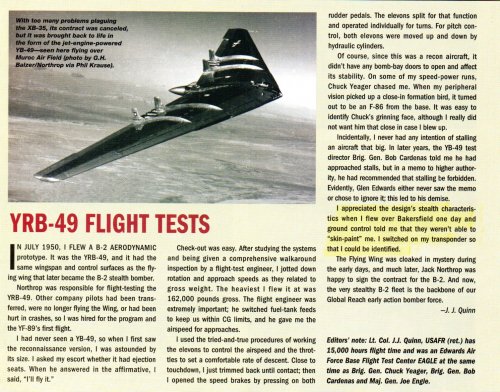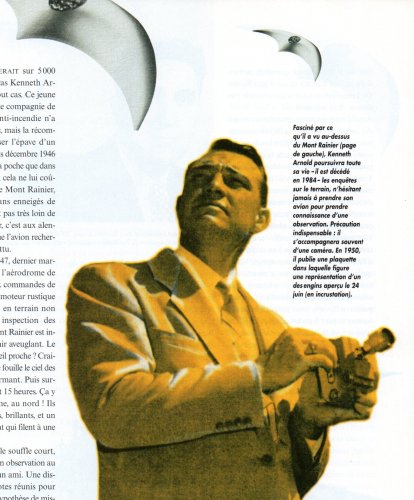- Joined
- 2 January 2011
- Messages
- 341
- Reaction score
- 345
In a recent thread on Horten Flying Wings, Justo Miranda shared some pages from his book "The Ultimate Flying Wings of the Luftwaffe". These pages discussed the application of "stealth" technologies to both submarines and aircraft. At the end of the selected pages are two paragraphs where he states that the B-49 project was cancelled due to its disappearance from radar screens with a subsequent effort to fool the Russians by cancelling the wings and substituting dead-end projects on saucer-shaped aircraft. I don't research German aircraft and don't have much in the way of documents, so I cannot really make much comment there however many questions I may have about supportive documentation to the statements made.
The Northrop Flying Wing commentary, however, is a different story.
First, however, we need to examine the use of the term "stealth". "Stealth" has absolutely no applicability when discussing any aircraft of the 1940s, 1950s and 1960s. The concept did not exist as we understand and use it today. Thus, while you can talk about sonar-absorbent materials on U-boats and lower radar cross-sections on some aircraft, it is not "stealth". The Mosquito and Ho 229 had lower cross-sections, but the Mossie certainly showed up on radar and the Ho 229 would have as well due to the big hunks of metal involved in the engines and guns and the Ho 229's metal internal framework. The model Ho 229 built and tested in the U.S. in recent years did not have any metal in it, as I recall, so tests made with radar are at least incomplete. Wood certainly is radar-transparent. Aluminum and steel are not.
Some rather stunning assertions were made about the Flying Wings and program being ended as a result of a 1947 "...unexplained disappearance from a radar screen of a gigantic bomber Northrop YB-49...", followed by the claim that the "Flying Saucers" projects such as the Avro were substituted to throw the Soviets off. He then suggests that the Soviet reverse-engineering of the B-29 and subsequent manufacturing of the Tu-4 copy was an end result of this entire process. The result is a hodge-podge of incorrect, conflicting and unsupported claims. If anything the fact that the Wing disappeared on a radar screen would, in fact, have been a logical and compelling reason to build the aircraft in mass quantities - had it been able to do the job.
Beginning with the B-29, the first Tu-4 flew in May, 1947, and almost immediately thereafter went into production. The reverse engineering process began in 1944 with the landing of at least four B-29s in Russian territory. The Soviet Union had previously requested B-29s via Lend-Lease on several occasions but were turned down in each case. Thus when the opportunity to dismantle, measure, test and redesign the most advanced production bomber in the world at the time came available Stalin literally pursued it with a vengeance. The Flying Wing had absolutely nothing to do with it.
In the meantime, there is a huge amount of clarification that needs doing.
The B-35 was designed in the early 1940s, based on the understanding of combat needs and available weapons of the time, the largest being the 4000lb bomb. By the time the B-35 actually flew most of that had changed. Piston-engine aircraft were rapidly becoming dinosaurs, enough so that a letter was issued by the Material Division in 1944 suggesting that no new bomber projects be undertaken until it could be determined how the "turbine engine" (including both turboprops and jets) would work out and what impact that would have on design. Putting jet engines in the B-35 was not the solution, either. The aircraft was not stressed for the higher speeds and thrust of jet engines. Even with the lower-thrust J-35 it was just not built to take it. The jet-powered B-49 was redlined at 500mph, at least 100mph slower than the B-47 which would soon be reaching full production. Test pilot Max Stanley flew the B-49 to 550mph at least once, and in doing so encountered aileron reversal.
In addition, the B-35 was built around the specific fuel consumption characteristics of the R-4360. The J-35 jet engine's fuel consumption was some four times that of the R-4360, dramatically limiting range. To put ANY jet engine into the Flying Wing would have required a major redesign of the aircraft that would have taken years to work out. The thickness of the Wing and the fuel-consumption of the jet engines reduced the B-49's capabilities to that of the medium bomber category where the B-47 - which also first flew in 1947 - was far superior in all aspects.
Finally, one is doomed if he ignores the post-war political and economic situation as it applied to military projects. The U.S. was dramatically cutting back on the size of its military while at the same time in a transitional time from piston engines to jets in almost all categories of aircraft. The USAF wanted a 70 Group force. They got 48. This meant that in many cases they made do with what they had or with variations on a theme such as the B-50 and, once the shortfalls and been corrected, the B-36. The USAF was placing the majority of its emphasis on medium and long-range bombers capable of dropping nuclear weapons on the enemy. Remember that this was the era of SAC. The Flying Wing just simply had no place in the post-war Air Force, especially with a far-superior advanced aircraft like the B-47 about to debut. The ultimate decision to cancel the Flying Wing was made by officers studying the current and future needs of a smaller Air Force moving to jets and large intercontinental bombers powered either by turboprops or jet engines. Had the B-36 not already been in production and the introduction of the jet pods not taken care of both speed and altitude deficiencies it undoubtedly would have been cancelled, too, as was discussed after the B-36As were produced.
Had the Soviets wanted to build a flying wing bomber they certainly had the capability to do so. Instead they built the Tu-4, which, as you recall, was flying by May, 1947. The B-35/49 project was not killed because of any super-secret plan to throw off the Soviets. Unless Mr. Miranda can produce specific original-source USAF and government documents showing that to be the case it must be placed in the waste can of interesting but baseless speculation.
The B-35 was essentially killed by the failure of GFE (Government Furnished Equipment) to be delivered that could solve a variety of issues, one the most important failing being a lack of gearboxes and propellers that worked for the counter-rotating props. Before any of those problems could be dealt with the switch was on to jets and that has already been addressed.
The simple fact is that the Flying Wings, no matter how sexy, had been bypassed by technology and budgetary considerations. They couldn't do the job for which they had originally been designed and just weren't needed.
And THAT, not some unsubstantiated plan to fool the Soviets, is what killed the Northrop Flying Wings.
The Northrop Flying Wing commentary, however, is a different story.
First, however, we need to examine the use of the term "stealth". "Stealth" has absolutely no applicability when discussing any aircraft of the 1940s, 1950s and 1960s. The concept did not exist as we understand and use it today. Thus, while you can talk about sonar-absorbent materials on U-boats and lower radar cross-sections on some aircraft, it is not "stealth". The Mosquito and Ho 229 had lower cross-sections, but the Mossie certainly showed up on radar and the Ho 229 would have as well due to the big hunks of metal involved in the engines and guns and the Ho 229's metal internal framework. The model Ho 229 built and tested in the U.S. in recent years did not have any metal in it, as I recall, so tests made with radar are at least incomplete. Wood certainly is radar-transparent. Aluminum and steel are not.
Some rather stunning assertions were made about the Flying Wings and program being ended as a result of a 1947 "...unexplained disappearance from a radar screen of a gigantic bomber Northrop YB-49...", followed by the claim that the "Flying Saucers" projects such as the Avro were substituted to throw the Soviets off. He then suggests that the Soviet reverse-engineering of the B-29 and subsequent manufacturing of the Tu-4 copy was an end result of this entire process. The result is a hodge-podge of incorrect, conflicting and unsupported claims. If anything the fact that the Wing disappeared on a radar screen would, in fact, have been a logical and compelling reason to build the aircraft in mass quantities - had it been able to do the job.
Beginning with the B-29, the first Tu-4 flew in May, 1947, and almost immediately thereafter went into production. The reverse engineering process began in 1944 with the landing of at least four B-29s in Russian territory. The Soviet Union had previously requested B-29s via Lend-Lease on several occasions but were turned down in each case. Thus when the opportunity to dismantle, measure, test and redesign the most advanced production bomber in the world at the time came available Stalin literally pursued it with a vengeance. The Flying Wing had absolutely nothing to do with it.
In the meantime, there is a huge amount of clarification that needs doing.
The B-35 was designed in the early 1940s, based on the understanding of combat needs and available weapons of the time, the largest being the 4000lb bomb. By the time the B-35 actually flew most of that had changed. Piston-engine aircraft were rapidly becoming dinosaurs, enough so that a letter was issued by the Material Division in 1944 suggesting that no new bomber projects be undertaken until it could be determined how the "turbine engine" (including both turboprops and jets) would work out and what impact that would have on design. Putting jet engines in the B-35 was not the solution, either. The aircraft was not stressed for the higher speeds and thrust of jet engines. Even with the lower-thrust J-35 it was just not built to take it. The jet-powered B-49 was redlined at 500mph, at least 100mph slower than the B-47 which would soon be reaching full production. Test pilot Max Stanley flew the B-49 to 550mph at least once, and in doing so encountered aileron reversal.
In addition, the B-35 was built around the specific fuel consumption characteristics of the R-4360. The J-35 jet engine's fuel consumption was some four times that of the R-4360, dramatically limiting range. To put ANY jet engine into the Flying Wing would have required a major redesign of the aircraft that would have taken years to work out. The thickness of the Wing and the fuel-consumption of the jet engines reduced the B-49's capabilities to that of the medium bomber category where the B-47 - which also first flew in 1947 - was far superior in all aspects.
Finally, one is doomed if he ignores the post-war political and economic situation as it applied to military projects. The U.S. was dramatically cutting back on the size of its military while at the same time in a transitional time from piston engines to jets in almost all categories of aircraft. The USAF wanted a 70 Group force. They got 48. This meant that in many cases they made do with what they had or with variations on a theme such as the B-50 and, once the shortfalls and been corrected, the B-36. The USAF was placing the majority of its emphasis on medium and long-range bombers capable of dropping nuclear weapons on the enemy. Remember that this was the era of SAC. The Flying Wing just simply had no place in the post-war Air Force, especially with a far-superior advanced aircraft like the B-47 about to debut. The ultimate decision to cancel the Flying Wing was made by officers studying the current and future needs of a smaller Air Force moving to jets and large intercontinental bombers powered either by turboprops or jet engines. Had the B-36 not already been in production and the introduction of the jet pods not taken care of both speed and altitude deficiencies it undoubtedly would have been cancelled, too, as was discussed after the B-36As were produced.
Had the Soviets wanted to build a flying wing bomber they certainly had the capability to do so. Instead they built the Tu-4, which, as you recall, was flying by May, 1947. The B-35/49 project was not killed because of any super-secret plan to throw off the Soviets. Unless Mr. Miranda can produce specific original-source USAF and government documents showing that to be the case it must be placed in the waste can of interesting but baseless speculation.
The B-35 was essentially killed by the failure of GFE (Government Furnished Equipment) to be delivered that could solve a variety of issues, one the most important failing being a lack of gearboxes and propellers that worked for the counter-rotating props. Before any of those problems could be dealt with the switch was on to jets and that has already been addressed.
The simple fact is that the Flying Wings, no matter how sexy, had been bypassed by technology and budgetary considerations. They couldn't do the job for which they had originally been designed and just weren't needed.
And THAT, not some unsubstantiated plan to fool the Soviets, is what killed the Northrop Flying Wings.




